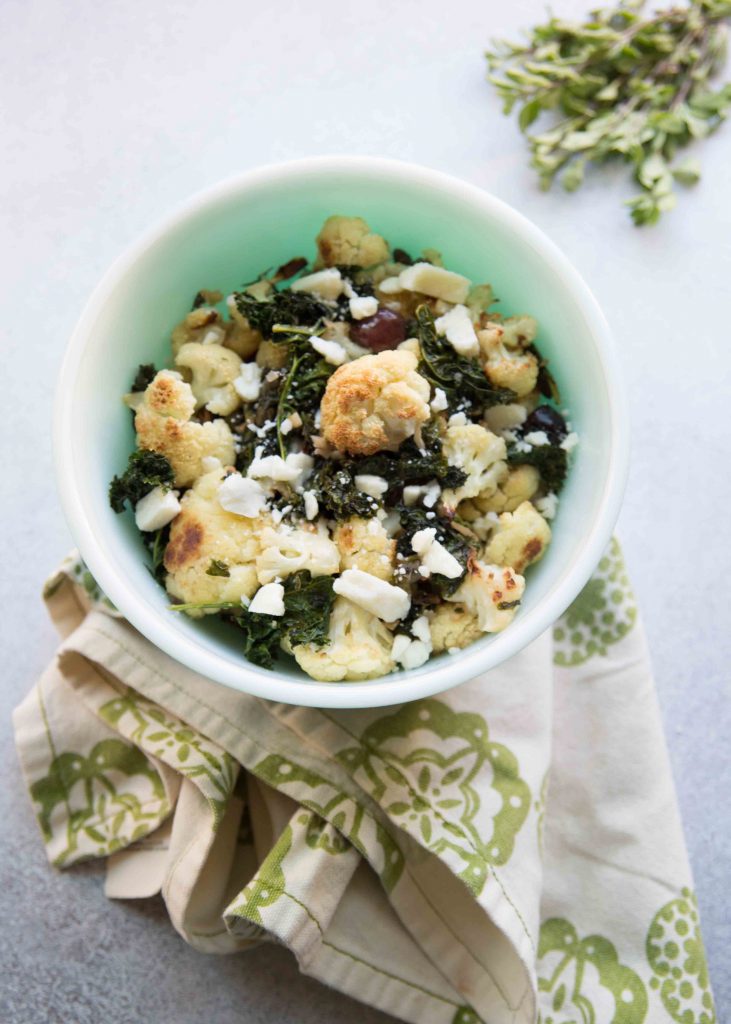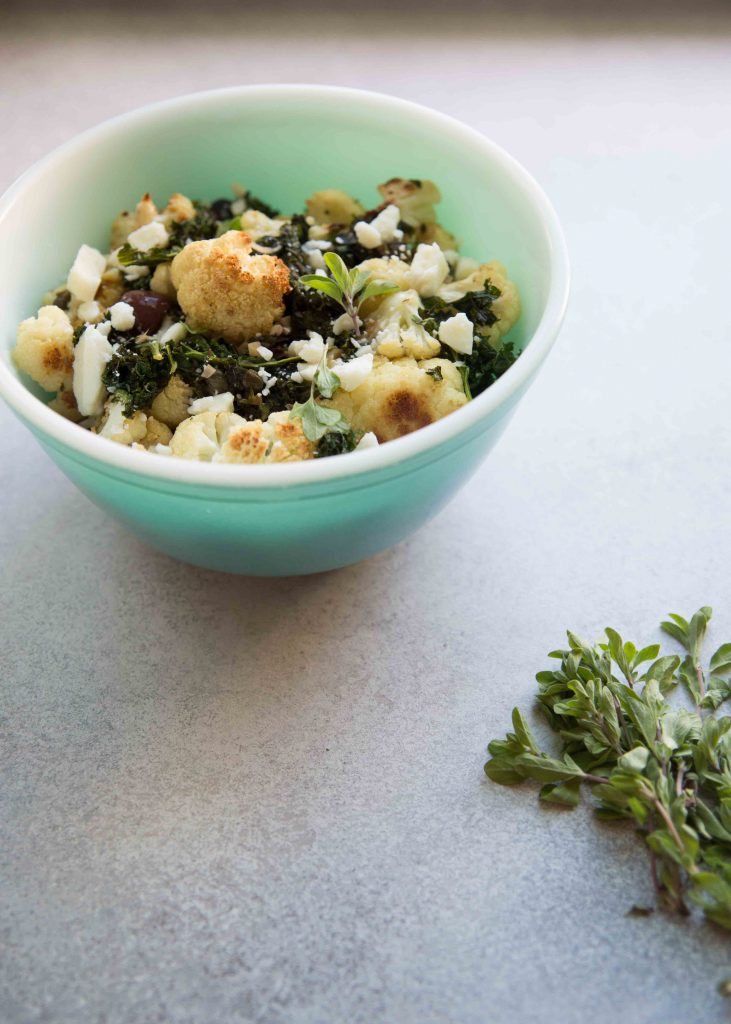
Winter vegetables can seem bleak without the variety of the summer harvest. It’s why of all the recipes I cooked from Myra Kornfeld and Stephen Massamilla’s food poetry cookbook, Cooking with the Muse, I asked if I could share her Mediterranean Cauliflower Kale Roast with Feta. This vegetarian side dish packs in bold flavors and served with baked tofu or salmon, is my kind of healthy meal. What makes their way of approaching recipes extra special is how Massimilla provides a poet’s note and in this case, a snippet from an Auden poem to accompany Kornfeld’s recipe creation. Food poetry synchronicity at its finest!
A poet’s hope: to be,
like some valley cheese,
local, but prized elsewhere.
—W.H. Auden, from “Shorts II”
Mediterranean Cauliflower Kale Roast with Feta
Recipe and poet’s note republished with permission from Cooking with the Muse by Myra Kornfeld and Stephen Massimilla (Tupelo Press, 2016).
Roasting gently browns the cauliflower florets and crisps the kale leaves, coaxing deep flavor out of the vegetables. Following this recipe will render them toasty and juicy at once. The combination of garlicky olives, capers, lemon, and oregano lends a slightly citrusy, almost buttery quality to the dish. A sprinkling of a good feta cheese from a pasture-raised sheep or goat adds one more element of delight and surprise. The literary history of pastured sheep’s and goat’s milk feta dates back to the Odyssey, a foundational epic poem of Western literature (see the Poet’s Note.)
Serves 4 to 6
1 head cauliflower, cut into florets
4 tablespoons extra virgin olive oil
Salt
3/4 pound curly kale, stemmed and torn into bite-size pieces
1 tablespoon unsalted butter
2 garlic cloves, minced
1/4 cup chopped pitted kalamata olives
1 tablespoon capers, drained, rinsed and chopped
1/4 cup water
2 tablespoons fresh oregano
1 tablespoon fresh lemon juice
Freshly ground black pepper
2 ounces feta cheese (preferably sheep’s milk feta), crumbled (1/2 cup)
- Preheat the oven to 375ºF. Have ready a parchment paper–covered baking sheet.
- In one bowl, toss the cauliflower with 2 tablespoons of the oil and 1/2 teaspoon salt. Spread the cauliflower on the baking sheet and roast for 30 minutes, turning once halfway through.
- In another bowl, toss the kale with 1 tablespoon oil. Massage the oil into the leaves so that each leaf is lightly coated. Sprinkle with 1/8 teaspoon salt.
- After the cauliflower has roasted for 30 minutes, add the kale to the baking sheet, return it to the oven, and roast for an additional 10 to 15 minutes, until the cauliflower is browned and the kale is crispy. Remove from the oven.
- Warm the remaining tablespoon of oil with the butter in a large skillet until the butter melts. Add the garlic, olives, and capers and cook for a minute or two, until fragrant. Stir in the cauliflower and kale, the water, and the oregano; combine thoroughly. Stir in the lemon juice and a sprinkling of pepper.
- Serve hot, with feta scattered on top.
Poet’s Note
This literary history of feta dates back to the 8th century BCE, though the emphasis in the epics that have come down to us was on hecatombs—sacrificial roasts of large animals on spits—the mainstay of a masculine warrior’s diet that was likely even then reserved for the upper classes. Feta, that tangy, salty, crumbly, quintessentially Greek cheese—which was originally aged and brined to keep well in a hot, arid climate—is described. Indeed, the equipment used to make sheep’s milk cheese in the Cyclops Polyphemus’s cave in Book IX of Homer’s Odyssey is much like that used by Greek shepherds to make feta today. Odysseus made the imprudent decision to raid the larder of a gigantic man-eating monster (who was fortunately myopic enough for Odysseus later to blind and outwit by escaping on the underbelly of a sheep, though some of his men didn’t fare so well):
We entered the cave and took stock of everything inside.
His baskets were loaded with cheeses, and his pens spilling
over with lambs and kids, divided into separate groups…
And all his vessels, milk pails, and pans into which he milked,
were brimming with whey. Seeing all this, my men begged me
to let them steal the cheeses, and make off with them to the ship…
but I wouldn’t listen to them; I wanted to meet
the owner first, in the hope that he’d give me a guest present.
Later, as they observe the giant, he goes on to prepare the whey cheese:
He drew off half of the milk to curdle it, and set it
aside in strainers made of wicker, stored for cheeses,
but let the other half stand in the milk pails…
Before disembarking on the island of the Cyclops, Odysseus and his men had surveyed the land with thoughts of colonizing it. They’d noticed that the carnivorous giants had no social customs and that their sheep were allowed to cavort everywhere without any pens to hold them. Though he and his crew were not in serious need of provisions and Odysseus was certainly foolish to tarry in the cave in hopes of receiving an extra “guest present” from an uncivilized monster, it is perhaps no surprise that Odysseus risked his life and those of his men to raid this cave for cheeses, lambs, and kids in the first place. Even by Archaic Greek standards, these livestock were seriously free range.
Greek cuisine in the 4th-century classical age was more sparing. The Greek poet Archestratus lived in Sicily, which was regarded by tradition to be the original island of the Cyclops. Archestratus, who lived there after it had really become a Greek colony, was perhaps the first Western cookbook writer whom we know of, though the fragments we have are from a parodic poem that advises the gastronomic reader on where to find the best food. His recipes rightly emphasize the fresh local quality of the ingredients.

